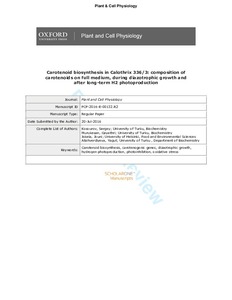Carotenoid Biosynthesis in Calothrix sp. 336/3: Composition of Carotenoids on Full Medium, During Diazotrophic Growth and After Long-Term H2 Photoproduction
Sergey Kosourov; Gayathri Murukesan; Jouni Jokela; Yagut Allahverdiyeva
https://urn.fi/URN:NBN:fi-fe2021042716349
Tiivistelmä
The carotenoid composition of the filamentous heterocystous N2-fixing cyanobacterium Calothrix sp. 336/3 was investigated under three conditions: in full medium (non-diazotrophic growth); in the absence of combined nitrogen (diazotrophic growth); and after long-term H2 photoproduction (diazotrophic medium and absence of nitrogen in atmosphere). Anabaena sp. PCC 7120 and its DeltahupL mutant with disrupted uptake hydrogenase were used as reference strains. Analysis of identified carotenoids and enzymes involved in carotenogenesis showed the presence of three distinct biosynthetic pathways in Calothrix sp. 336/3. The first one is directed towards biosynthesis of myxoxanthophylls, such as myxol 2'-methylpentoside and 2-hydroxymyxol 2'-methylpentoside. The second pathway results in production of hydroxylated carotenoids, such as zeaxanthin, caloxanthin and nostoxanthin, and the last pathway is responsible for biosynthesis of echinenone and hydroxylated forms of ketocarotenoids, such as 3'-hydroxyechinenone and adonixanthin. We found that carotenogenesis in filamentous heterocystous cyanobacteria varies depending on the nitrogen status of the cultures, with significant accumulation of echinenone during diazotrophic growth at the expense of beta-carotene. Under the severe N-deficiency and high CO2 supply, which leads to efficient H2 photoproduction, cyanobacteria degrade echinenone and beta-carotene and accumulate glycosylated and hydroxylated carotenoids, such as myxol (or ketomyxol) 2'- methylpentosides, 3'-hydroxyechinenone and zeaxanthin. We suggest that the stability of the photosynthetic apparatus in Calothrix sp. 336/3 cells under N-deficiency and high carbon conditions, which is also appeared as the partial recovery of the pigment composition by the end of the long-term ( approximately 1 month) H2 photoproduction process, might be mediated by a high content of hydroxycarotenoids.
Kokoelmat
- Rinnakkaistallenteet [27094]
